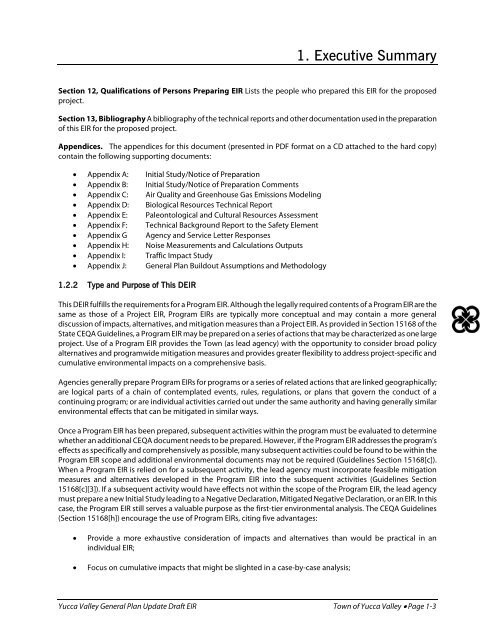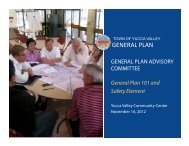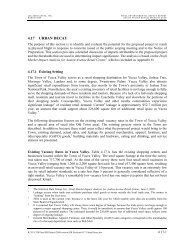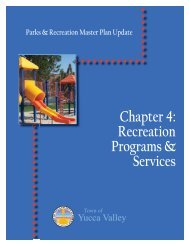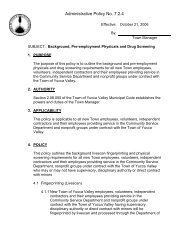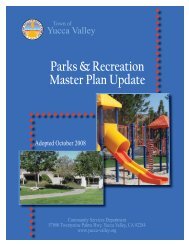Section 1 Executive Summary - Town of Yucca Valley
Section 1 Executive Summary - Town of Yucca Valley
Section 1 Executive Summary - Town of Yucca Valley
Create successful ePaper yourself
Turn your PDF publications into a flip-book with our unique Google optimized e-Paper software.
1. <strong>Executive</strong> <strong>Summary</strong><br />
<strong>Section</strong> 12, Qualifications <strong>of</strong> Persons Preparing EIR Lists the people who prepared this EIR for the proposed<br />
project.<br />
<strong>Section</strong> 13, Bibliography A bibliography <strong>of</strong> the technical reports and other documentation used in the preparation<br />
<strong>of</strong> this EIR for the proposed project.<br />
Appendices. The appendices for this document (presented in PDF format on a CD attached to the hard copy)<br />
contain the following supporting documents:<br />
• Appendix A: Initial Study/Notice <strong>of</strong> Preparation<br />
• Appendix B: Initial Study/Notice <strong>of</strong> Preparation Comments<br />
• Appendix C: Air Quality and Greenhouse Gas Emissions Modeling<br />
• Appendix D: Biological Resources Technical Report<br />
• Appendix E: Paleontological and Cultural Resources Assessment<br />
• Appendix F: Technical Background Report to the Safety Element<br />
• Appendix G Agency and Service Letter Responses<br />
• Appendix H: Noise Measurements and Calculations Outputs<br />
• Appendix I: Traffic Impact Study<br />
• Appendix J: General Plan Buildout Assumptions and Methodology<br />
1.2.2 Type and Purpose <strong>of</strong> This DEIR<br />
This DEIR fulfills the requirements for a Program EIR. Although the legally required contents <strong>of</strong> a Program EIR are the<br />
same as those <strong>of</strong> a Project EIR, Program EIRs are typically more conceptual and may contain a more general<br />
discussion <strong>of</strong> impacts, alternatives, and mitigation measures than a Project EIR. As provided in <strong>Section</strong> 15168 <strong>of</strong> the<br />
State CEQA Guidelines, a Program EIR may be prepared on a series <strong>of</strong> actions that may be characterized as one large<br />
project. Use <strong>of</strong> a Program EIR provides the <strong>Town</strong> (as lead agency) with the opportunity to consider broad policy<br />
alternatives and programwide mitigation measures and provides greater flexibility to address project-specific and<br />
cumulative environmental impacts on a comprehensive basis.<br />
Agencies generally prepare Program EIRs for programs or a series <strong>of</strong> related actions that are linked geographically;<br />
are logical parts <strong>of</strong> a chain <strong>of</strong> contemplated events, rules, regulations, or plans that govern the conduct <strong>of</strong> a<br />
continuing program; or are individual activities carried out under the same authority and having generally similar<br />
environmental effects that can be mitigated in similar ways.<br />
Once a Program EIR has been prepared, subsequent activities within the program must be evaluated to determine<br />
whether an additional CEQA document needs to be prepared. However, if the Program EIR addresses the program’s<br />
effects as specifically and comprehensively as possible, many subsequent activities could be found to be within the<br />
Program EIR scope and additional environmental documents may not be required (Guidelines <strong>Section</strong> 15168[c]).<br />
When a Program EIR is relied on for a subsequent activity, the lead agency must incorporate feasible mitigation<br />
measures and alternatives developed in the Program EIR into the subsequent activities (Guidelines <strong>Section</strong><br />
15168[c][3]). If a subsequent activity would have effects not within the scope <strong>of</strong> the Program EIR, the lead agency<br />
must prepare a new Initial Study leading to a Negative Declaration, Mitigated Negative Declaration, or an EIR. In this<br />
case, the Program EIR still serves a valuable purpose as the first-tier environmental analysis. The CEQA Guidelines<br />
(<strong>Section</strong> 15168[h]) encourage the use <strong>of</strong> Program EIRs, citing five advantages:<br />
• Provide a more exhaustive consideration <strong>of</strong> impacts and alternatives than would be practical in an<br />
individual EIR;<br />
• Focus on cumulative impacts that might be slighted in a case-by-case analysis;<br />
<strong>Yucca</strong> <strong>Valley</strong> General Plan Update Draft EIR <strong>Town</strong> <strong>of</strong> <strong>Yucca</strong> <strong>Valley</strong> • Page 1-3


